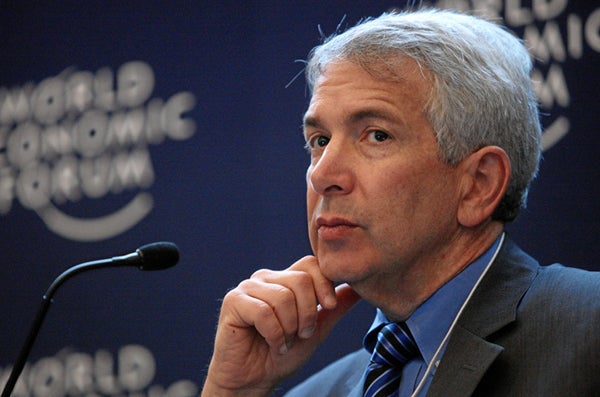
Fred Krupp, President of the Environmental Defense Fund and early champion of third-stage environmentalism.
In November 1986 the president of the Environmental Defense Fund, Fred Krupp, authored an essay in the Wall Street Journal championing a “new strategy” in environmentalism. An emphasis on “economic well-being” and “coalitions of former enemies” were hallmarks of the strategy. Krupp christened the movement “third-stage environmentalism.” In the thirty years since the third-stage emerged it has become the norm. But Krupp’s project is now twice as old as mainstream, second-stage, environmentalism was when he first confronted it. With decades of experience, it is time to concede that the third stage has not lived up to expectations.
In Krupp’s essay he described “first-stage” environmentalism as Teddy Roosevelt’s wilderness conservation, which led to our national parks and forests. The “second stage” was Rachel Carson’s ecological awakening, which motivated our traditional environmental laws, those characterized by robust federal regulations, science-based standards, and to the chagrin of some, litigation.
The “third-stage” environmentalism that Krupp outlined would adopt more diverse tactics, welcoming in economic concerns and corporate partnership. It would “not accept ‘either-or’ as inevitable,” instead striving for win-win solutions for profit and environmental protection.
Krupp was prescient. Today, market-based solutions are a starting point for environmental policy, from pollution to extraction (for example, here, here, here, here, here, here, and here). Some environmental groups are more likely to consult on corporate operations than to sue for environmental misdeeds. This transition stems from some astonishing early successes of third-stage environmentalism.
Perhaps the greatest triumph occurred in 1990 when Environmental Defense Fund worked with the Bush Administration on a market-based program to reduce acid rain. Since this cap-and-trade law took effect, acid rain pollution plunged faster and at a far lower cost than anyone predicted. Industry won new revenue opportunities and humans won a cleaner environment.
This achievement was the product of a new political context in which third-stage environmentalism could thrive. In 1986, environmental protection remained popular even while President Reagan’s agenda weakened political support for regulation. Third-stage environmentalism offered tactical pluralism that would address environmental goals without alienating political factions.
But during thirty years of the third stage something changed. By focusing the environmental movement more on conciliation and less on strengthening the underlying consensus of values, the third-stage constrained the type of political strategies that are available to environmental advocates. Today, if there is manifest need for environmental protection—as with climate change—but a proposed solution does not obviously and immediately deliver win-win outcomes, regulated industries and their political allies can too easily dismiss the policy as old-fashioned, as “second-stage.”
By promising abundant collaborative solutions, third-stage environmentalism has fostered new expectations of what counts as acceptable environmental policy. The 1990 acid rain trading program was a pathbreaking solution that grew from Krupp’s 1986 OpEd. It was bi-partisan, low cost, and effective. But in its greatest successes, third-stage environmentalism has cemented expectations of win-win outcomes and, in turn, fostered intolerance for regulatory costs, for policies that are a win for the environment but not for industry. Today, cap-and-trade is as iconic a political failure for climate change as it was a success for acid rain.
The third stage, with its emphasis on cooperation, has also increased tolerance for policies that weaken environmental safeguards. By endorsing industry self-governance as a sign of good environmental policy, we now often fail to see past industry engagement and towards environmental outcomes. Last spring, for instance, a court allowed an industry-led, market-based, conservation plan for the imperiled Dunes Sagebrush Lizard to substitute for robust Endangered Species Act requirements even though the plan is voluntary, unenforceable, and confidential, even to the federal government. The plan has allowed significant new habitat destruction. Third-stage environmentalism promised collaboration and market mechanisms would help achieve win-win solutions, but now we praise them for their own sake.
By helping regulatory opponents dismiss any policy that does not provide economic benefits or make room for industry self-governance, third-stage environmentalism has facilitated erosion of environmentalism rather than the global consensus that it promised.
The upshot is that the downsides of third-stage environmentalism are not without precedent and solutions are already available. Expansive flexibility, control of regulatory decisions by regulated entities, and limited judicial enforcement were common before the environmental laws of the 1970s. Like today, we offered vested interests generous control over their own governance. But standards, transparency, and public enforcement through the judiciary were auspicious solutions. Congress specifically integrated these features into the nation’s foundational environmental laws. Thus, second-stage environmentalism wasn’t just a response to new notions of the human-environment relationship; it was also a response to political failures. The third stage presented a new cooperative emphasis, but it inadvertently undercut this political pillar of environmental law.
What third-stage environmentalism offers is a deeply held commitment to environmental protection but without confidence in and attention towards the values necessary to maintain and grow that commitment. As a result, for the last thirty years, we have developed a diverse policy toolbox but we have lost the consensus that generates the political power necessary to use these tools effectively.
But there is no need for another reinvention. Luckily, as Krupp promised, third-stage environmentalism was not “in any way a repudiation of the second stage.” Today, thirty years later, traditional environmental laws still exist and we can renew our focus on them, and new laws in their image. We can renew our focus on the strong and effective tactics they establish. And we can renew our focus on the deep commitments to environmental protection that they embody. This may seem impossible in today’s political climate, but environmentalism has always been about the long-run.
